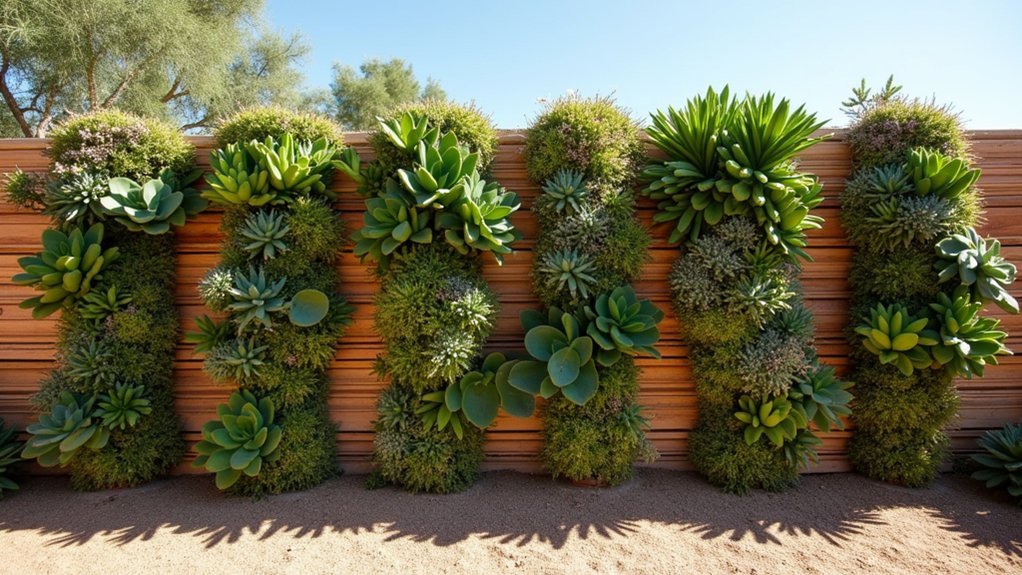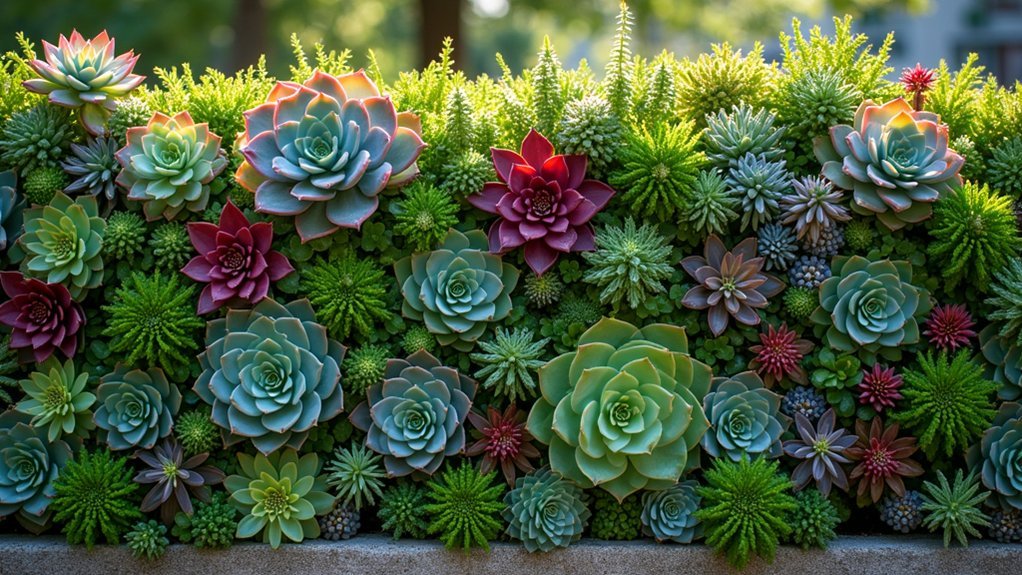For perfect living fences, try columnar varieties like Jade Plant and Aloe vera that grow tall and dense. Cascading options such as Burro’s Tail, String of Pearls, and Ruby Necklace create lush barriers with distinctive draping effects. Plant them in well-draining soil (4:2:1 ratio) and position in bright, indirect light. You’ll need minimal maintenance—water only every 2-3 weeks. These natural boundaries thrive in USDA zones 9-11 and offer beautiful, drought-resistant privacy solutions.
Top 8 Succulents for Creating Natural Privacy Screens

Eight stunning succulents can transform your outdoor space into a secluded oasis while adding natural beauty.
The Jade plant grows tall and dense, creating a stunning natural barrier that’s drought tolerant. Pair it with cascading Burro’s Tail, whose trailing stems form lush curtains of green.
The stately Jade creates living walls of resilience while Burro’s Tail drapes elegantly, forming verdant privacy screens.
Hens-and-Chicks thrive in various climates, making them great privacy solutions when planted closely. For height variation, incorporate String of Pearls with its distinctive cascading growth pattern.
The vibrant Pink Wandering Jew attracts pollinators while enhancing privacy.
Complete your living fence with Aloe vera and Echeveria for diverse textures.
These succulent plants require low maintenance while effectively blocking unwanted views. You’ll enjoy both privacy and beauty with minimal watering – perfect for busy homeowners seeking natural screening solutions.
Building Stackable Succulent Walls With Columnar Varieties
Columnar succulents offer a remarkable opportunity to build vertical living fences that maximize limited space while creating striking visual impact.
Varieties like Jade Plant and Aloe vera grow upright, making them perfect candidates for stackable succulent walls in your garden.
When constructing these living barriers, you’ll need a specialized cactus soil mix (4 parts potting soil, 2 parts sand, 1 part perlite) to guarantee proper drainage and prevent root rot.
Position your wall where it receives bright but indirect light to prevent leaf scorching.
These succulents thrive in USDA Hardiness Zones 9-11, though you’ll need to protect them from frost in colder regions.
Drought-Resistant Succulent Fencing Options for Arid Climates

While water scarcity presents challenges for traditional fencing, drought-resistant succulents offer an elegant solution for creating living barriers in arid climates.
Nature’s wisdom shines brightest in the desert, where succulents transform barren boundaries into thriving, water-wise living walls.
You’ll find that plants like Ruby Necklace and Burro’s Tail thrive with minimal irrigation, making them excellent choices for your vertical gardens in drought conditions.
- String of Dolphins and String of Pearls create cascading effects over fence edges, adding dimension to your Living Wall
- Jade plants and Hens-and-Chicks introduce vibrant colors that withstand temperatures between 70-85°F
- These tolerant plants require minimal maintenance while providing both functionality and beauty
- Mixing various succulent varieties maximizes space efficiency while creating a lush green barrier that stands up to arid environments
Designing Your Vertical Succulent Boundary: Structure and Support
Creating a thriving vertical succulent fence requires careful attention to the underlying structure that will support your living boundary. Select durable materials like treated lumber or reclaimed wood, guaranteeing your structure can bear the combined weight of plants and soil.
Frame the interior with 2x4s, keeping it lightweight enough for indoor placement if desired. For aesthetic appeal, cut the outer reclaimed wood at 45-degree angles. Predrilling holes simplifies assembly and strengthens the overall support.
Line the bottom of your succulent garden with landscape fabric and wire to provide essential drainage while preventing soil loss.
The orientation of your structure greatly impacts plant health—position your living fence to receive bright, indirect sunlight exposure. This thoughtful design approach guarantees your vertical boundary becomes a stunning, sustainable feature that thrives for years.
Year-Round Maintenance Tips for Thriving Succulent Barriers

Maintaining your vertical succulent fence requires consistent attention that alters with the seasons. Your living barrier will thrive with proper care across all hardiness zones, even when some varieties need to shift to indoor hanging arrangements during harsh winters.
- Position your fence to receive bright indirect light, preventing both scorching and leggy growth.
- Water only when soil is completely dry—succulents need little water every 2-3 weeks.
- Use well-draining soil with a 4:2:1 ratio of potting soil, sand, and perlite to prevent root rot.
- Monitor for pests and promptly remove unhealthy foliage, especially during seasonal shifts.
Year-round maintenance involves adapting your care routine to seasonal changes.
During colder months, protect sensitive varieties by bringing them indoors or providing shelter to guarantee your living fence remains beautiful throughout the year.
Frequently Asked Questions
What Succulent Grows Vertically?
You’ll love vertical-growing succulents like String of Pearls, Donkey Tail, and Variegated String of Hearts. They’ll trail downward up to 12 feet, while Hens-and-Chicks create textured vertical displays with their rosette formations.
How to Create a Vertical Succulent Garden?
Build a planting box with treated lumber and drainage. Mix well-draining soil. Plan your succulent layout, then secure them with wire. Create holes with spoons or screws. Place in bright, indirect light and don’t overwater.
Are There Any Succulents That Climb?
While traditional succulents don’t climb, you’ll love String of Hearts, Burro’s Tail, and String of Dolphins for their trailing habits. They cascade beautifully, creating a climbing appearance when planted in vertical arrangements or hanging baskets.
Do Succulents Make Good Ground Cover?
Yes, you’ll find succulents make excellent ground cover. They’re drought-resistant, low-maintenance, and spread to form dense carpets that suppress weeds. Their varied colors and textures create beautiful, sustainable coverage in your garden with minimal effort.
In Summary
You’ll find vertical succulents create stunning, functional boundaries for your space. Whether you’ve chosen columnar cacti, trailing varieties, or stacked arrangements, these living fences offer privacy with minimal water needs. Remember to check your support structures seasonally, trim as needed, and protect sensitive varieties during extreme weather. With proper care, your succulent fence will continue to enhance your landscape for years to come.





Leave a Reply